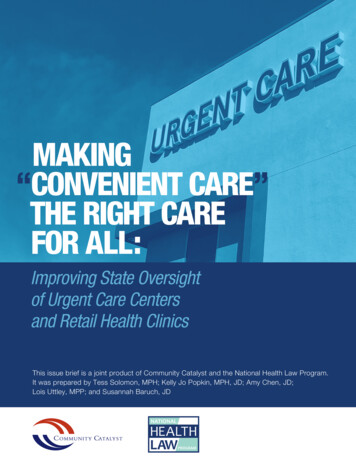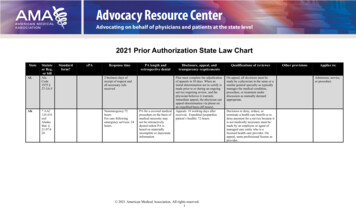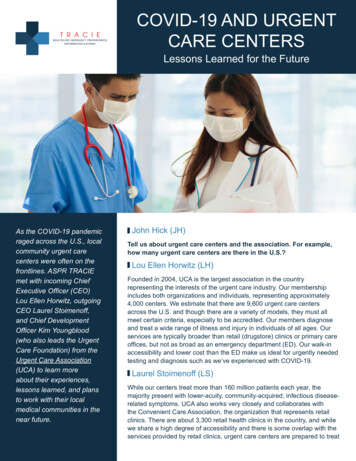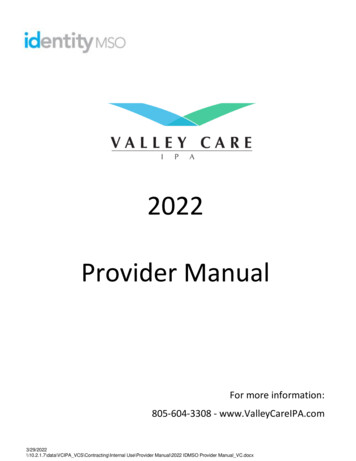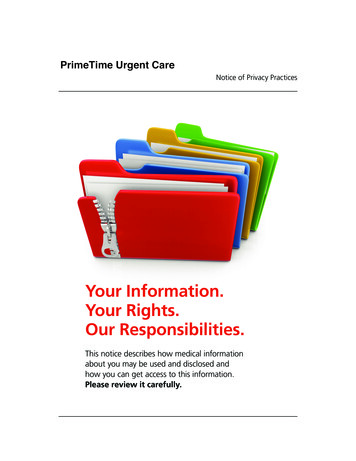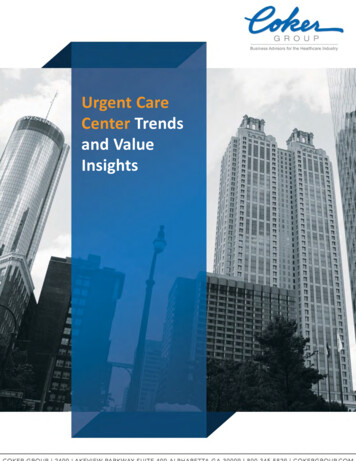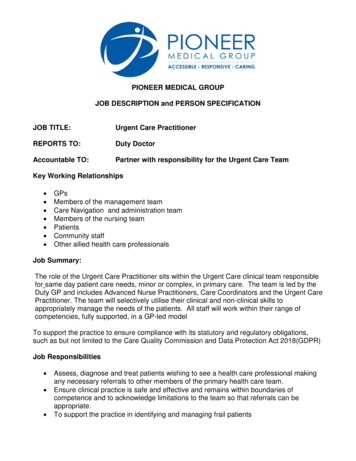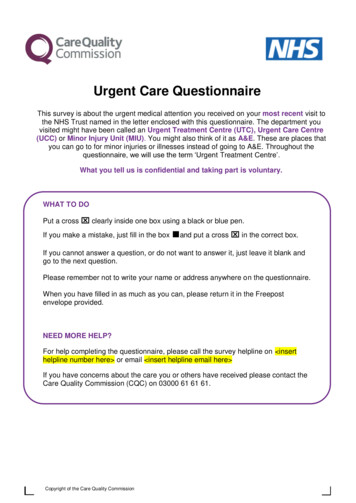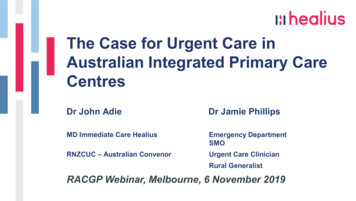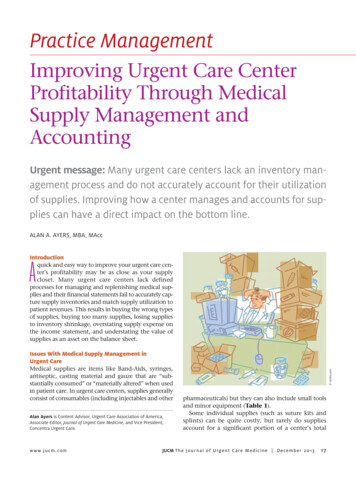
Transcription
Practice ManagementImproving Urgent Care CenterProfitability Through MedicalSupply Management andAccountingUrgent message: Many urgent care centers lack an inventory management process and do not accurately account for their utilizationof supplies. Improving how a center manages and accounts for supplies can have a direct impact on the bottom line.ALAN A. AYERS, MBA, MAccIntroductionAquick and easy way to improve your urgent care center’s profitability may be as close as your supplycloset. Many urgent care centers lack definedprocesses for managing and replenishing medical supplies and their financial statements fail to accurately capture supply inventories and match supply utilization topatient revenues. This results in buying the wrong typesof supplies, buying too many supplies, losing suppliesto inventory shrinkage, overstating supply expense onthe income statement, and understating the value ofsupplies as an asset on the balance sheet.Medical supplies are items like Band-Aids, syringes,antiseptic, casting material and gauze that are “substantially consumed” or “materially altered” when usedin patient care. In urgent care centers, supplies generallyconsist of consumables (including injectables and otherAlan Ayers is Content Advisor, Urgent Care Association of America,Associate Editor, Journal of Urgent Care Medicine, and Vice President,Concentra Urgent Care.w w w. j u c m . c o m corbis.comIssues With Medical Supply Management inUrgent Carepharmaceuticals) but they can also include small toolsand minor equipment (Table 1).Some individual supplies (such as suture kits andsplints) can be quite costly, but rarely do suppliesaccount for a significant portion of a center’s totalJUCM T h e J o u r n a l o f U r g e n t C a r e M e d i c i n e D e c e m b e r 2 0 1 317
IMPROVING URGENT CARE CENTER PROFITABILITY THROUGH MEDICAL SUPPLY MANAGEMENT AND ACCOUNTINGTable 1. Accounting for Minor EquipmentAlthough most of what constitutes “medical supplies” in anurgent care setting are consumables used in patient care,there are a number of handheld diagnostic tools that havecosts below the threshold of a depreciable asset. Examplesinclude electronic thermometers, scopes, and bloodpressure cuffs. Instead of carrying these items on thebalance sheet as a long-term asset and expensingdepreciation—as is done for furnishings, fixtures, andequipment—minor equipment is typically expensed aspurchased. These items should be assigned to rooms andchecked daily to prevent loss.Table 2. Common Internal Control Weaknesses andStrategies to Improve Controls Related to MedicalSupply InventoriesCommon InternalControl Weaknesses Lack of a consensus formulary—duplicative orredundant SKUs are carried in inventory. Lack of utilization statistics—center administrators do not track howfrequently items are usedor replenished. Lack of visibility of currentinventory—supplies areexpensed as ordered,meaning the value ofsupplies is not accuratelydepicted as a center asset. Lack of minimum onhand or “trigger” re-orderquantities—orderingoccurs when items“appear” low or are closeto running out with littledata to support thedecision. Lack of purchase approvalprocesses—purchaseorders are processedwithout managementreview. Lack of physical controls—supplies are stored inlocations throughout thecenter versus one central,lockable supply closet.18Strategies to Improve Control Engage physicians, nursesand administrators indeveloping a “formulary” tohelp eliminate duplicativeSKUs and identify cheaperor more desirablealternative products whenavailable. Interview staff and “walkthrough” the existing ordersystem and identifyweaknesses andprocedures that areparticularly timeconsuming. Implement a structuredinventory managementprocess or system to tracksupplies on hand and usedin patient care, and tofacilitate re-orders. Usesystem reports to createaccounting entries. Review all the locationsthat are used for storage.Keep unopened supplies ina central, locked closet andsign out to specific storageareas or to individualpatients if billable.expenses. Supplies used are much less extensive than in,say, surgical centers, because most urgent care visits arefor low-acuity infections, cold/flu, skin conditions, allergies, etc. Perhaps because medical supplies are viewed as“incidental” to treating patients and are not a majorexpense category like salaries and rent, many urgent carecenters simply “write-off” supplies without further consideration.Supply Management Starts With a ConsensusFormularyIn referring to medical supplies, a stock-keeping unit(SKU) refers to a unique item. In your kitchen cupboard, for instance, “oatmeal” may constitute a single“product” but in a supermarket, each distinct brand, flavor, and box size constitutes a separate “SKU.” Thisgrocery analogy is relevant because—just as any cerealon the shelf may satisfy your morning hunger—yoururgent care center likely carries multiple SKUs that servethe same clinical purpose. Without an agreed-uponsupply “formulary,” if Provider A wants one brand ofsuture kit and Provider B (who only works weekends)wants a different brand, it’s common for a center tostock both SKUs to appease both providers.If all of a center’s providers can agree on one SKU foreach clinical function—giving fair consideration toquality and price—the number of SKUs ordered andstored by the center can be reduced. In addition, by concentrating all orders for a product into one SKU, the center can better take advantage of quantity discounts. Toprevent providers and others in the center from ordering whatever they want or need on a whim, however,a formal policy should require that additions or deviations from the formulary be approved by the center’smedical director.The Need for Formal Supply Management ProcessesEven when there’s a consensus formulary, many centers lack formal supply management processes toensure that the “right” quantities of supplies arealways on hand. When administrators cannot trackhow frequently items are used or replenished, theytend to place orders when inventories “appear low” oractually run out. But because running out of a criticalsupply can impair patient care, it’s likely the centeradministrator orders and stores far greater quantitiesthan would normally be used in the subsequent weeksor months.Given that major medical supply houses such asMcKesson, PSS World Medical, and Henry Schein offerJUCM T h e J o u r n a l o f U r g e n t C a r e M e d i c i n e D e c e m b e r 2 0 1 3w w w. j u c m . c o m
IMPROVING URGENT CARE CENTER PROFITABILITY THROUGH MEDICAL SUPPLY MANAGEMENT AND ACCOUNTINGservice level agreements ensuring 48- to 72-hour delivery of nearly any item in their catalogs, a center reallyhas no need to carry more than a couple weeks’ worthof supplies at any given time. Larger inventories increasethe risk of shrinkage as supplies expire, spoil, becomedamaged, or are pilfered. And when these excess quantities start to crowd central storage spaces, supplies endup in exam room cabinets, provider station drawers, andother locations throughout the center—further obscuring visibility as to what supplies are on hand.Electronic Supply Management SystemsA variety of Web-based, supplier-provided and standalone inventory management systems have beendesigned for medical practices can be implemented inan urgent care center. These systems expand upon theuse of the SKU identifier to:䡲 Track current inventory levels against theformulary;䡲 Track the date supplies were received, number ofw w w. j u c m . c o mdays on hand, and days until expiration;䡲 Track supply utilization by category, type, SKUand lot;䡲 Charge supplies to specific patients, clients or business units;䡲 Identify minimum on-hand and trigger reorderquantities;䡲 Create, track and process requisitions and purchaseorders;䡲 Integrate with supply vendors for electronic ordering and auto-replenishment;䡲 Reconcile accounts payable invoices to purchaseorders and receipts; and䡲 Create inventory reports to facilitate physicalcounting.Electronic inventory systems are most effective whenintegrated with bar code technology. Using a handhelddevice, staff “scans” the bar codes on individual itemsas they’re consumed in patient care (or on boxes asJUCM T h e J o u r n a l o f U r g e n t C a r e M e d i c i n e D e c e m b e r 2 0 1 3 Use medical ear piercing to bring new families into your business Generate a new source of cash revenue Patented technology available only through physicians 179 investment creates an opportunity to increaseyour patient base while generating a profit!19
IMPROVING URGENT CARE CENTER PROFITABILITY THROUGH MEDICAL SUPPLY MANAGEMENT AND ACCOUNTINGTable 3. Comparison of Accounting Methods for Medical Supplies in Urgent CareAccounting Method Used by ManyCenters: Expense Supplies as UsedHybrid Method: Expense Supplies asUsed but True-up Balance SheetGenerally Accepted AccountingPrinciples: Accurate Valuation ofSupplies on Balance Sheet Initial Value of Supplies Not Carried asa Balance Sheet Asset Purchase Supplies: Debit the ExpenseAccount Utilize Supplies: No Entry No Ending Supply Inventory Occurs Starting Asset: Initial Value of Supplies Purchase Supplies: Debit the ExpenseAccount Utilize Supplies: No Entry Year-end Inventory: True-Up the AssetAccount; Debit or Credit the ExpenseAccount Starting Asset: Initial Value of Supplies Purchase Supplies: Debit the AssetAccount Utilize Supplies:Credit the Asset AccountDebit the Expense Account Monthly or Quarterly Inventory:True-Up the Asset AccountDebit or Credit the Expense AccountBenefits: Easy—all supplies are expensed aspurchased; does not require aninventory management system Overstating supplies expense mayreduce taxable incomeBenefits: Considers the value of supplies held asa center assetBenefits: More accurately reflects value ofsupplies held as a center asset More accurately reflects the cost ofsupplies (used to serve patients)during a particular periodDrawbacks: Typically undervalues the asset ofsupplies on hand Typically overstates the cost ofsupplies used in patient care Can trigger IRS audit foroverstatement of supplies expenseDrawbacks: Supplies expense can varysignificantly based on timing ofpurchases Supplies expense is not reflective ofsupply utilization associated withpatient revenueDrawbacks: Requires greater effort in managingsupply inventories, which can beaided by technology and processimprovementsthey’re opened or removed from the storage closeti).The system then electronically updates inventoryrecords, facilitating on-demand reports of supplies onhand and those used during a reporting period. Periodicinventory can be facilitated using the bar code scannerand system reports. The system can even indicate whenquantities fall to preset “reorder” levels. More sophisticated systems can automatically create a purchaseorder and submit an electronic order to the supplyvendor for fulfillment.Not all urgent care centers will want to computerizetheir ordering and inventory management processes.But applying simple internal control procedures androutine authorizations for expenditures will still significantly help in managing supply costs. When an inventory system is implemented, quantities in use and onhand tend to be consistent and, therefore, accuratei. Accounting rules generally consider a box containing multiple items to be “consumed”and “no longer in storage” once the box is opened. At this point the entire contents ofthe box should be expensed.20records lead to generation of a more consistent monthover-month supply expense on the income statement;reduction in overstock, waste and spoilage; and moreefficient use of storage space.Account for Supply UtilizationFrom an accounting standpoint, an urgent care center’smanagement is responsible for the accurate presentationof financial statements prepared for use by creditors andinvestors under Generally Accepted Accounting Principles (GAAP). Accurately representing Supply Expense onthe Income Statement and the value of Supply Inventory on the Balance Sheet requires adequate financialcontrols, as illustrated in Table 2.Often urgent care centers do not maintain accuratesupply inventories on their books because theyexpense all supplies at the time of purchase. The issuewith this—illustrated by Table 3—is that an asset worthup to 50,000 (in aggregate) is hidden away in cabinets, drawers, and under sinks while the Balance SheetJUCM T h e J o u r n a l o f U r g e n t C a r e M e d i c i n e D e c e m b e r 2 0 1 3w w w. j u c m . c o m
IMPROVING URGENT CARE CENTER PROFITABILITY“Many urgent care centers simply ‘write-off’supplies without further consideration.”understates the value of owners’ equity in the business.Moreover, the common practice of expensing all supplies uponpurchase violates accounting principles that call for revenue andexpenses to be matched during the same period each is incurred. Inany given month that a large supply order is processed, suppliesexpense as a percent of patient revenue may climb, leading toincorrect conclusions being drawn from the income statement.Likewise, a center could improve its profitability in a given monthby just not placing any supply orders.As illustrated in Table 3, center accounting for supplies could beimproved by carrying a beginning supply inventory on the balancesheet, continuing to expense supplies as used, and doing a periodic“true-up” based on a physical inventory count. But the best alternative is to record purchases in the inventory (asset) account andmake a periodic journal entry (weekly or monthly) to expense supplies that are used. The availability of data from an inventory management system facilitates this routine. In addition, a physicalinventory will be matched to the account balances and any differences analyzed. With supply expense more reflective of utilization,a center operator can more effectively identify trends, includingchanges in supply costs.Payor Reimbursement for Medical SuppliesIn general, urgent care centers are not specifically reimbursed forsupplies used in the ordinary treatment of patients. This is particularly true when a center has contracts that pay a “flat fee” or“global rate” per visit. But some fee-for-service contracts do reimburse some supplies—particularly supplies used in procedureslike casting and suturing. Thus, center administrators shouldunderstand which supplies are reimbursed by which payors usingwhich codes. When supplies are reimbursable, a process shouldbe in place to accurately capture supply utilization on thepatient’s charge ticket. Providers, medical assistants, and chargeentry staff also need to be educated as to which payors reimbursewhich supplies to ensure chart documentation such that thecenter receives its full reimbursement.ConclusionImproving your urgent care center’s medical supply managementprocesses can have a direct impact on its financials by better tying supply utilization expense to patient revenue and by better reflecting supplies on hand as an asset of the center. Effective supply managementin urgent care entails establishing a formulary, implementingprocesses related to the storage and replenishment of supplies, capturing supply utilization and shrink, and establishing proper accounting practices. JUCM T h e J o u r n a l o f U r g e n t C a r e M e d i c i n e D e c e m b e r 2 0 1 321One-Stop ShoppingIs Just a Mouse ClickAwayThe Urgent Care Buyer’s Guide IsOnline on the JUCM WebsiteIf you like the hardcopy edition ofthe JUCM Urgent Care Buyer’sGuide, you will love the online edition on the JUCM website. Everyword, every photo, every ad andlisting that appears on the hardcopy edition of the Buyer’s Guide isin the online edition. Plus the online edition of the Buyer’s Guide isinteractive.䡲 Click on any web address andyou will be taken directly to thatwebsite.䡲 Click on any email address toconnect directly with an expertat the vendor.䡲 Click on any entry in theCompany Index at the back ofthe guide and jump right to thatcompany’s ad or listing withinthe guide.䡲 The online edition of the UrgentCare Buyer’s Guide is convenientto use and always accessible.www.urgentcarebuyersguide.com
Practice Management Improving Urgent Care Center Profitability Through Medical Supply Management and Accounting Urgent message: Many urgent care centers lack an inventory man-agement process and do not accurately account for their utilization of supplies. Improving how a center manages and accounts for sup-
